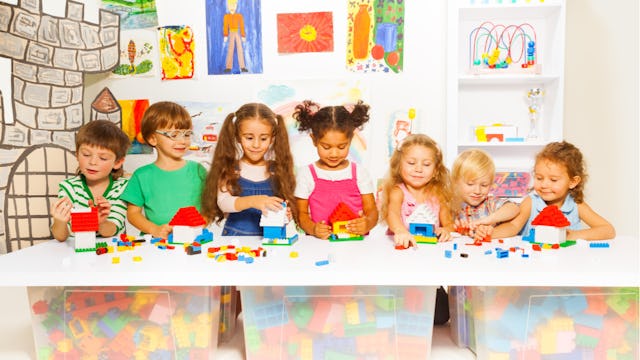Can We PLEASE Bring Back 'Play' In Kindergarten?

Picture this, if you will: a kindergarten classroom circa 1977. Avocado-colored file cabinets, kids in floral-printed bell bottoms chilling out on beanbags while flipping through the pages of actual books (no swiping screens), real chalkboards, and in every corner, some type of learning center filled with children playing. PLAYING.
And at each of those learning centers, nothing needs to be plugged in, except for that large tape recorder playing an audio version of “One Fish, Two Fish, Red Fish, Blue Fish.” Instead, play is happening. Pure, uninterrupted, unrestricted, unmediated, (mostly) unsupervised free play.
That was my kindergarten experience. We hung out in the play kitchen and art center, and spent hours at recess making up games instead of being told what and how to play on the playground. We played with water and sand tables, rummaged through the dress-up closet, stacked giant wooden blocks to the ceiling and back, and endlessly used our imaginations to ignite social interactions and supplement the curriculum.
Now picture a kindergarten classroom today. Sure, it’s bright and shiny, but it’s also stacked to the gills with virtual everything. Smart Boards, desktop computers, iPads, reading tablets, classroom libraries filled with chapter books (what happened to all the picture books?), and individual desks meant to be sat at for six hours a day. (A 5-year-old can’t sit at a desk for more than 10 minutes at a time, but sure, let’s sit them at a desk and expect them to freewrite in their journal for 20 minutes.) And lest we forget, kindergarten back then was only a half-day, and yet somehow it managed to turn out a generation of smart, literate, and innovative people.
I’m not the only one who contends that kindergarten has jumped the shark.
Over the last few years, educators around the country have been lamenting how we now expect 5-year-old children to arrive at kindergarten independently reading at a level well beyond their years and confidently writing full sentences. According to education researcher Christopher Brown, studies show that “5-year-olds are spending more time engaged in teacher-led academic learning activities than play-based learning opportunities that facilitate child-initiated investigations and foster social development among peers.”
Brown, who has been observing and researching modern kindergarten classrooms, notes that on average kindergarten students are engaged in 15 different academic activities per day, with only a 15-minute recess. He says kindergarten teachers agree that is too much work for their students, and that both students and teachers feel pressure to perform at a higher academic level.
Due to local and state education mandates, teachers are under tremendous pressure to constantly assess multiple areas of a student’s academic performance, with extensive math and literacy assessments now being required in kindergarten. Kindergarten.
So why do we need to bring back free play? Why is it so important?
Because play at this age is the cornerstone for learning, and its benefits have long been validated by research. Play-based curriculum and child-centered learning activities at this age have shown that young children’s literacy can be promoted in a play-centered environment and that children’s play is contingent on their learning.
Play doesn’t negate learning. Play is learning.
Of course, we want our our children to be challenged and succeed academically while at the same time gaining a love of learning. But we’re doing our kindergartners a great disservice by replacing recess and play with a high-pressure learning environment. Somehow we need to find a more balanced level of instruction in the early years of education — before we all end up with 5–7-year-olds with school anxiety and burnout.